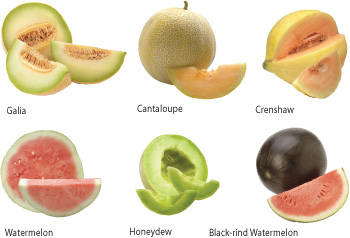Hot days, cool melons
This article was originally published in August 2011

It’s a summer tradition
Bite into a succulent melon and let its sweet juice drip down your face. Along with vitamin C, vitamin A and potassium, a cool, fat slice of melon is as healthy as it is irresistible!
Our organic melons come from Inaba Farms in Yakima, Wash. and several Oregon growers. We’ve got plenty to please — black rind and yellow flesh watermelons, honeydew, cantaloupe, Crenshaw and Galia. Get them while they’re in season, they don’t last long …
Cantaloupe
Cantaloupe derives its name from the Italian village of Cantalupo, where supposedly this type of melon first was grown in Europe. The orange flesh is firm and sweet.
Galia melon
A hybrid cross of cantaloupe and honeydew, Galia originally were developed by growers in Israel. The Galia looks like a cantaloupe on the outside and a honeydew on the inside. Its light green, smooth-textured flesh has a flavor more subtle than honeydew, but it’s still very sweet.
Tip: To choose a ripe cantaloupe or Galia melon, look for a yellow rather than green color under the webbing of the skin. A ripe melon should feel slightly soft and smell fragrant.
Honeydew
This slightly oval melon is distinguished by a smooth, whitish skin and exceptionally juicy, tender flesh. It’s very sweet due to its high sugar content. We have honeydews with green or orange flesh.
Crenshaw melon
A cross between a Casaba and Persian melon, this melon has a smooth, yellowish skin and salmon-colored, silky flesh with a sweet honey flavor.
Tip: To choose a ripe honeydew or Crenshaw melon, very gently press the stem end. If the rind gives a little, it’s ripe!
Watermelon
92 percent water by weight, watermelons are the most thirst quenching of the melons. In addition to vitamin C and vitamin A, watermelon has B vitamins and lycopene, a powerful antioxidant also found in tomatoes.
Tip: To choose a ripe watermelon, look for the spot where it sat on the ground; if the spot is yellow, it means the melon ripened on the vine longer. If the spot is white, the melon won’t be as ripe. Then tap or knock the melon. If your tap vibrates to the bottom, the melon will be nice and crisp.
Local melons are in season June through September. Get cooking with melons »
Did you know? Melon trivia
- Melons first were cultivated in ancient Egypt.
- Watermelons were in hieroglyphics painted on building walls. The fruit was so prized that it was placed in the tombs of many Egyptian kings.
- Melons have been grown by the Chinese, Greeks and Romans for thousands of years, only reaching Europe during the Renaissance.
- Melons reached the New World with European colonists and African slaves, and were cultivated by Native Americans.
- Watermelons have been an important part of African agriculture in that they are not only a food plant but also a vital source of water — referred to as “botanical canteens.”
- In a number of traditional African cuisines, watermelon seeds (rich in edible oils and protein) and flesh are used in cooking. They’re also often served as a cooked vegetable.
- Melon fruits, roots, leaves and seeds play important roles in the treatment of a wide range of health problems in Chinese traditional medicine.
- Watermelon seeds are ground into flour and baked as bread in some parts of India.
In Russia, watermelon juice is fermented into an alcoholic beverage. - Melons belong to the same family as the cucumber, squash, pumpkin and gourd, and like many of its relatives, grows on the ground on a trailing vine.
